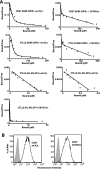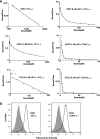The role of interchain heterodisulfide formation in activation of the human common beta and mouse betaIL-3 receptors
- PMID: 20516062
- PMCID: PMC2915712
- DOI: 10.1074/jbc.M109.097881
The role of interchain heterodisulfide formation in activation of the human common beta and mouse betaIL-3 receptors
Abstract
The cytokines, interleukin-3 (IL-3), interleukin-5 (IL-5), and granulocyte-macrophage colony-stimulating factor (GM-CSF), exhibit overlapping activities in the regulation of hematopoietic cells. In humans, the common beta (betac) receptor is shared by the three cytokines and functions together with cytokine-specific alpha subunits in signaling. A widely accepted hypothesis is that receptor activation requires heterodisulfide formation between the domain 1 D-E loop disulfide in human betac (hbetac) and unidentified cysteine residues in the N-terminal domains of the alpha receptors. Since the development of this hypothesis, new data have been obtained showing that domain 1 of hbetac is part of the cytokine binding epitope of this receptor and that an IL-3Ralpha isoform lacking the N-terminal Ig-like domain (the "SP2" isoform) is competent for signaling. We therefore investigated whether distortion of the domain 1-domain 4 ligand-binding epitope in hbetac and the related mouse receptor, beta(IL-3), could account for the loss of receptor signaling when the domain 1 D-E loop disulfide is disrupted. Indeed, mutation of the disulfide in hbetac led to both a complete loss of high affinity binding with the human IL-3Ralpha SP2 isoform and of downstream signaling. Mutation of the orthologous residues in the mouse IL-3-specific receptor, beta(IL-3), not only precluded direct binding of mouse IL-3 but also resulted in complete loss of high affinity binding and signaling with the mouse IL-3Ralpha SP2 isoform. Our data are most consistent with a role for the domain 1 D-E loop disulfide of hbetac and beta(IL-3) in maintaining the precise positions of ligand-binding residues necessary for normal high affinity binding and signaling.
Figures






Similar articles
-
Interleukin-3 binding to the murine betaIL-3 and human betac receptors involves functional epitopes formed by domains 1 and 4 of different protein chains.J Biol Chem. 2004 Jun 18;279(25):26500-8. doi: 10.1074/jbc.M402705200. Epub 2004 Apr 1. J Biol Chem. 2004. PMID: 15060062
-
Identification of a Cys motif in the common beta chain of the interleukin 3, granulocyte-macrophage colony-stimulating factor, and interleukin 5 receptors essential for disulfide-linked receptor heterodimerization and activation of all three receptors.J Biol Chem. 1998 Jan 9;273(2):1192-9. doi: 10.1074/jbc.273.2.1192. J Biol Chem. 1998. PMID: 9422786
-
A single tyrosine residue in the membrane-proximal domain of the granulocyte-macrophage colony-stimulating factor, interleukin (IL)-3, and IL-5 receptor common beta-chain is necessary and sufficient for high affinity binding and signaling by all three ligands.J Biol Chem. 1996 Oct 18;271(42):25999-6006. doi: 10.1074/jbc.271.42.25999. J Biol Chem. 1996. PMID: 8824238
-
IL-3, IL-5, and GM-CSF signaling: crystal structure of the human beta-common receptor.Vitam Horm. 2006;74:1-30. doi: 10.1016/S0083-6729(06)74001-8. Vitam Horm. 2006. PMID: 17027509 Review.
-
Signaling domains of the beta c chain of the GM-CSF/IL-3/IL-5 receptor.Ann N Y Acad Sci. 1999 Apr 30;872:305-12; discussion 312-3. doi: 10.1111/j.1749-6632.1999.tb08474.x. Ann N Y Acad Sci. 1999. PMID: 10372132 Review.
Cited by
-
The receptor that tames the innate immune response.Mol Med. 2012 May 9;18(1):486-96. doi: 10.2119/molmed.2011.00414. Mol Med. 2012. PMID: 22183892 Free PMC article. Review.
References
-
- Kopf M., Brombacher F., Hodgkin P. D., Ramsay A. J., Milbourne E. A., Dai W. J., Ovington K. S., Behm C. A., Köhler G., Young I. G., Matthaei K. I. (1996) Immunity 4, 15–24 - PubMed
-
- Lantz C. S., Boesiger J., Song C. H., Mach N., Kobayashi T., Mulligan R. C., Nawa Y., Dranoff G., Galli S. J. (1998) Nature 392, 90–93 - PubMed
-
- Hamilton J. A. (2008) Nat. Rev. Immunol. 8, 533–544 - PubMed
Publication types
MeSH terms
Substances
LinkOut - more resources
Full Text Sources

